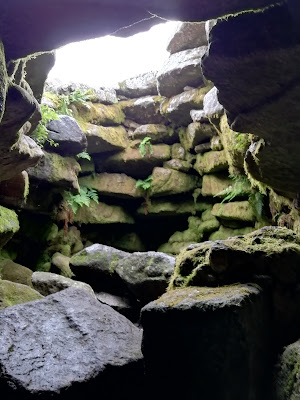In County Wicklow close to the Dublin border lies Seefin Passage Tomb.
At one time it was little known and seldom visited but with the rise in outdoor activities and Hill walking it has seen a lot more visitors over recent decades.
Seefin is in a class of archaeological monuments known as Passage Tombs, its better know relations being Newgrange in Meath and Loughcrew.
Seefin Passage Tomb can only be accessed by walking cross country and uphill for about 20 minutes and it isn't on any tourist trail.
Hiking boots are recommended.
Unlike Newgrange, Knowth and Dowth, Seefin lacks detailed intricate Rock Art however its location, and weather permitting, views across the countryside from its mountaintop location more than make up for this.
It is stated in various places that there are small amounts of Rock Art here however I haven't seen it myself so perhaps I just need to look closer.
On the hilltop next to Seefin is Seefingan which also has a large Passage Tomb on it but it has never been excavated or breached so its secrets still lie buried within it until such time as archaeologists investigate it.
Irelands Neolithic period
(stone age)
is generally given as 4500 to 2500 B.C. so Seefin is at least 4500 years old and perhaps older with 6500 years ago being taken as the start of Ireland's Neolithic era.
To enter the Passage tomb at Seefin you can either crawl through the passage itself or drop down through the hole in the damaged roof.
Normally I would advise against climbing onto the tomb cairns however the roof at Seefin has been opened up to the elements.
The passage leads to the inner chamber which has five side chambers, some damaged. There were never valuables in Passage tombs during Neolithic times.
Initially only cremated human bones were buried inside them. These remains were placed onto large urns/bowls and housed in the side chambers.
No remains were found at Seefin when it was investigated so it could have been previously raided in a misguided search for booty or loot. Perhaps the people moved out of the area and took the remains of their dead with them, we will never know for sure.
Early archaeological investigations of Passage Tombs were often hurried and destructive affairs as those who were excavating were usually in a hurry and hoping to find valuables such as Gold or precious stones, perhaps carved or ground into jewellery however nothing but cremated human bones were ever buried in Passage Tombs by Neolithic peoples.
Occasionally there were finds of carved animal bones, broken pottery and small beads in Passage Tombs but nothing that would swell a Raiders bank balance.
Occasionally there were finds of carved animal bones, broken pottery and small beads in Passage Tombs but nothing that would swell a Raiders bank balance.
It does seem however that later cultures reusing the Passage Tombs possibly added things into their burials as votive offerings such as fancy beads and jewellery. Roman coins have also been found at Newgrange and Passage Tombs were reused and utilised even in the Iron age.
The huge flat stones used for roof corbels would originally have been picked, sorted, and carefully positioned while the many stones used to build the cairn all had to be moved by hand.
All this was done without machinery and on the top of a mountain as well. Quite a feat of craftmanship and engineering. When they were sealed up these tombs remained perfectly dry for thousands of years.
Who were the people who built these monuments to their dead, where did they come from, and why did they put such a huge effort into building these Stone age Passage Tombs?
We can but wonder and look at them in awe..........
Coordinates here :
Coordinates here :
53°11'10.8"N 6°23'40.8"W
53.186330 - 6.394656








